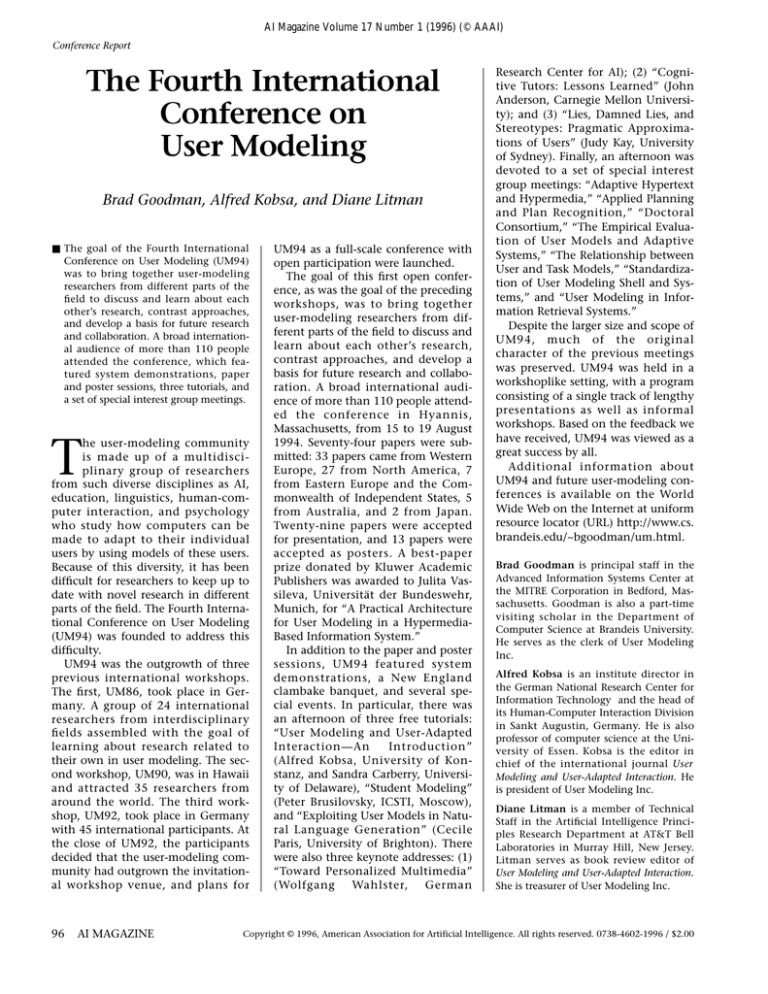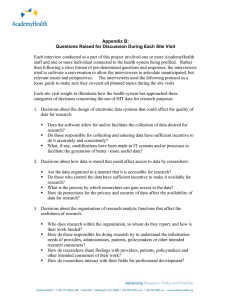
AI Magazine Volume 17 Number 1 (1996) (© AAAI)
Conference Report
The Fourth International
Conference on
User Modeling
Brad Goodman, Alfred Kobsa, and Diane Litman
■ The goal of the Fourth International
Conference on User Modeling (UM94)
was to bring together user-modeling
researchers from different parts of the
field to discuss and learn about each
other’s research, contrast approaches,
and develop a basis for future research
and collaboration. A broad international audience of more than 110 people
attended the conference, which featured system demonstrations, paper
and poster sessions, three tutorials, and
a set of special interest group meetings.
T
he user-modeling community
is made up of a multidisciplinary group of researchers
from such diverse disciplines as AI,
education, linguistics, human-computer interaction, and psychology
who study how computers can be
made to adapt to their individual
users by using models of these users.
Because of this diversity, it has been
difficult for researchers to keep up to
date with novel research in different
parts of the field. The Fourth International Conference on User Modeling
(UM94) was founded to address this
difficulty.
UM94 was the outgrowth of three
previous international workshops.
The first, UM86, took place in Germany. A group of 24 international
researchers from interdisciplinary
fields assembled with the goal of
learning about research related to
their own in user modeling. The second workshop, UM90, was in Hawaii
and attracted 35 researchers from
around the world. The third workshop, UM92, took place in Germany
with 45 international participants. At
the close of UM92, the participants
decided that the user-modeling community had outgrown the invitational workshop venue, and plans for
96
AI MAGAZINE
UM94 as a full-scale conference with
open participation were launched.
The goal of this first open conference, as was the goal of the preceding
workshops, was to bring together
user-modeling researchers from different parts of the field to discuss and
learn about each other’s research,
contrast approaches, and develop a
basis for future research and collaboration. A broad international audience of more than 110 people attended the conference in Hyannis,
Massachusetts, from 15 to 19 August
1994. Seventy-four papers were submitted: 33 papers came from Western
Europe, 27 from North America, 7
from Eastern Europe and the Commonwealth of Independent States, 5
from Australia, and 2 from Japan.
Twenty-nine papers were accepted
for presentation, and 13 papers were
accepted as posters. A best-paper
prize donated by Kluwer Academic
Publishers was awarded to Julita Vassileva, Universität der Bundeswehr,
Munich, for “A Practical Architecture
for User Modeling in a HypermediaBased Information System.”
In addition to the paper and poster
sessions, UM94 featured system
demonstrations, a New England
clambake banquet, and several special events. In particular, there was
an afternoon of three free tutorials:
“User Modeling and User-Adapted
Interaction—An
Introduction”
(Alfred Kobsa, University of Konstanz, and Sandra Carberry, University of Delaware), “Student Modeling”
(Peter Brusilovsky, ICSTI, Moscow),
and “Exploiting User Models in Natural Language Generation” (Cecile
Paris, University of Brighton). There
were also three keynote addresses: (1)
“Toward Personalized Multimedia”
(Wolfgang
Wahlster,
German
Research Center for AI); (2) “Cognitive Tutors: Lessons Learned” (John
Anderson, Carnegie Mellon University); and (3) “Lies, Damned Lies, and
Stereotypes: Pragmatic Approximations of Users” (Judy Kay, University
of Sydney). Finally, an afternoon was
devoted to a set of special interest
group meetings: “Adaptive Hypertext
and Hypermedia,” “Applied Planning
and Plan Recognition,” “Doctoral
Consortium,” “The Empirical Evaluation of User Models and Adaptive
Systems,” “The Relationship between
User and Task Models,” “Standardization of User Modeling Shell and Systems,” and “User Modeling in Information Retrieval Systems.”
Despite the larger size and scope of
UM94, much of the original
character of the previous meetings
was preserved. UM94 was held in a
workshoplike setting, with a program
consisting of a single track of lengthy
presentations as well as informal
workshops. Based on the feedback we
have received, UM94 was viewed as a
great success by all.
Additional information about
UM94 and future user-modeling conferences is available on the World
Wide Web on the Internet at uniform
resource locator (URL) http://www.cs.
brandeis.edu/~bgoodman/um.html.
Brad Goodman is principal staff in the
Advanced Information Systems Center at
the MITRE Corporation in Bedford, Massachusetts. Goodman is also a part-time
visiting scholar in the Department of
Computer Science at Brandeis University.
He serves as the clerk of User Modeling
Inc.
Alfred Kobsa is an institute director in
the German National Research Center for
Information Technology and the head of
its Human-Computer Interaction Division
in Sankt Augustin, Germany. He is also
professor of computer science at the University of Essen. Kobsa is the editor in
chief of the international journal User
Modeling and User-Adapted Interaction. He
is president of User Modeling Inc.
Diane Litman is a member of Technical
Staff in the Artificial Intelligence Principles Research Department at AT&T Bell
Laboratories in Murray Hill, New Jersey.
Litman serves as book review editor of
User Modeling and User-Adapted Interaction.
She is treasurer of User Modeling Inc.
Copyright © 1996, American Association for Artificial Intelligence. All rights reserved. 0738-4602-1996 / $2.00


